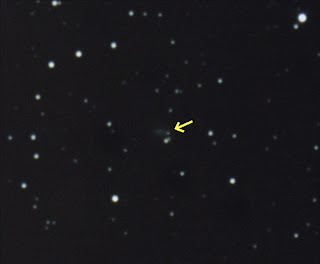 This is SN2011at in PGC26905 Hydra. I would like to get into doing something useful so I thought I’d make a start by finding what supernovae were out there. I found this on AAVSO.org (American Association of Variable Star Observers). Variable stars are not really my interest, but making an accurate measurement of the brightness (photometry) would give me some satisfaction, and if it were to become easy or routine to measure, it might just become rewarding enough to contribute to ‘citizen science’. I have authored a few papers so am aware of what is required, and it is usually a lot of work and stress being accurate enough. However, with the equipment here in front of me it seems a bit of a shame to use it on frivolous fancy pictures alone (as lovely as they are!). Now we have an Atik, we just need a V filter to speed up the process. The trouble with photometry with a DSLR is the green channel data only approximates a V filter and needs to be corrected using the colour (Blue-Visible) value as well as the atmospheric extinction and field flatness.
This is SN2011at in PGC26905 Hydra. I would like to get into doing something useful so I thought I’d make a start by finding what supernovae were out there. I found this on AAVSO.org (American Association of Variable Star Observers). Variable stars are not really my interest, but making an accurate measurement of the brightness (photometry) would give me some satisfaction, and if it were to become easy or routine to measure, it might just become rewarding enough to contribute to ‘citizen science’. I have authored a few papers so am aware of what is required, and it is usually a lot of work and stress being accurate enough. However, with the equipment here in front of me it seems a bit of a shame to use it on frivolous fancy pictures alone (as lovely as they are!). Now we have an Atik, we just need a V filter to speed up the process. The trouble with photometry with a DSLR is the green channel data only approximates a V filter and needs to be corrected using the colour (Blue-Visible) value as well as the atmospheric extinction and field flatness.I got an estimate of 14.90mag at 2320UT (06/04/2011) but that could have been out by + or – 0.20mag and I didn’t have a good selection of reference star data (error based on differences between reference stars and measured values). If B-V for the supernova is 0 then there is a +0.13 correction, so it is 15.03 mag, if B-V=0.7 then correction is 0. The image was also so blurred that the supernova light mixed with the galaxy and some nearby stars. So there could be another + correction. Still … pretty good for a start, and for a faint PGC galaxy low down in Southern Hydra.







